by Anne M. Yoder
The Mennonite Heritage Center (a Conference-Related Ministry, Harleysville, PA) hosted a program on Saturday, March 23 to celebrate Women’s History Month. Some registrants were kept away due to the torrential rains of that day, but a small and enthusiastic group did gather. The program was conceived by MHC’s Education Committee and part of its mission was to highlight archival collections that held the papers of women who were missionaries or involved in a medical profession. There are often glimpses in personal papers that can inform and inspire us today, and it was wonderful to find some at the MHC as well as other archives. The bulk of what was discovered was of Mennonite women active from 1894 to 1928.
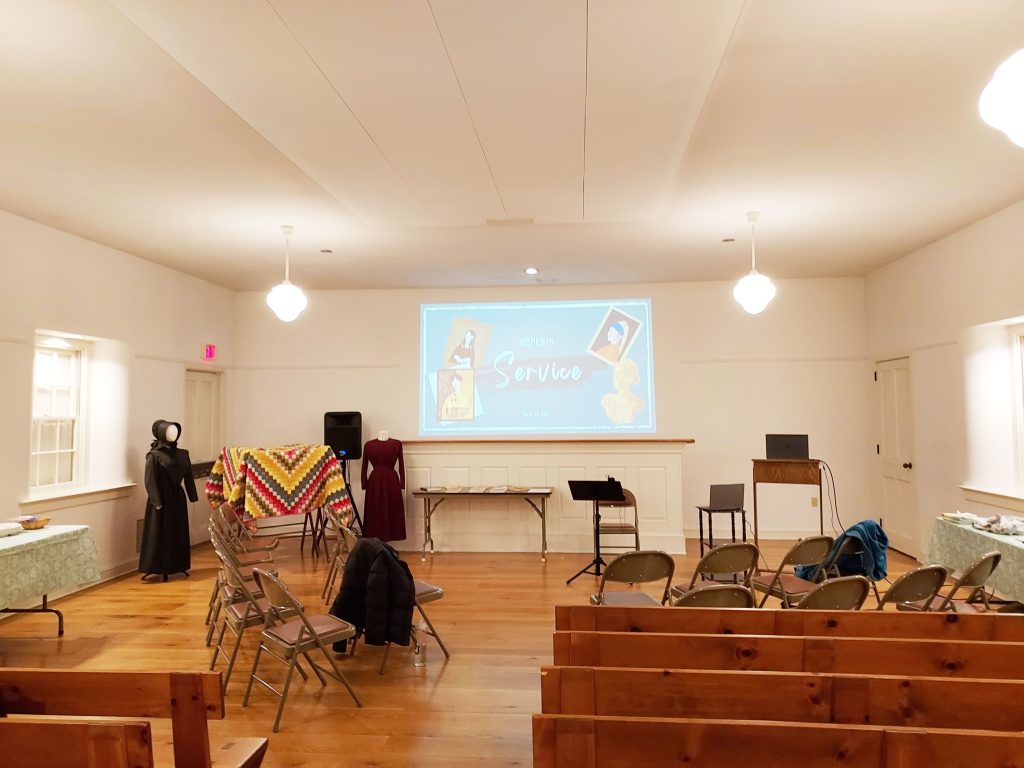
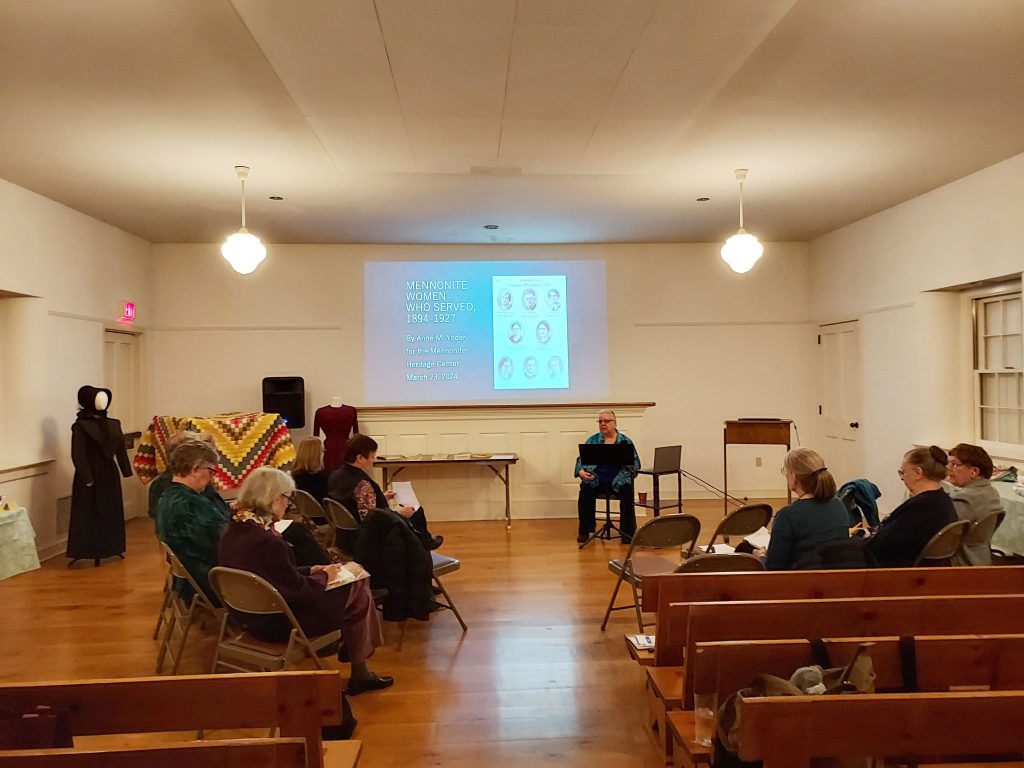
Regina Wenger, Educational Curator, in her spirited introduction, shared that this was a period of tremendous change for Christian women, including Mennonites. They began to organize their own societies and mission outreach networks, and single and married women became part of movements to bring about social change (for example, through the temperance crusade) and to share the Gospel. Their abilities and intellect shined in their increasingly public roles, and they gained authority in places where, for example, they were the only doctors in a large area of a country.
My presentation was about Mennonite women who left their home environments to work in missions in U.S. cities or overseas, particularly in India, or as army nurses in Europe during World War I. Their diaries and letters illuminated their sense of calling, the challenges they found when they arrived, how they were perceived by others they met or to whom they ministered, and reflections about God. A quote by Sara Shisler, a missionary in Nigeria, who wrote in 1927, moved us all: “These [Bura] girls are beautiful…One does not need to try to love them, one just does…. In educating them, we are not handing anything down, only sharing what we have. May our sharing be done in justice and love.” [Sara C. Shisler Collection (Hist. Mss. 1-214), Mennonite Heritage Center]
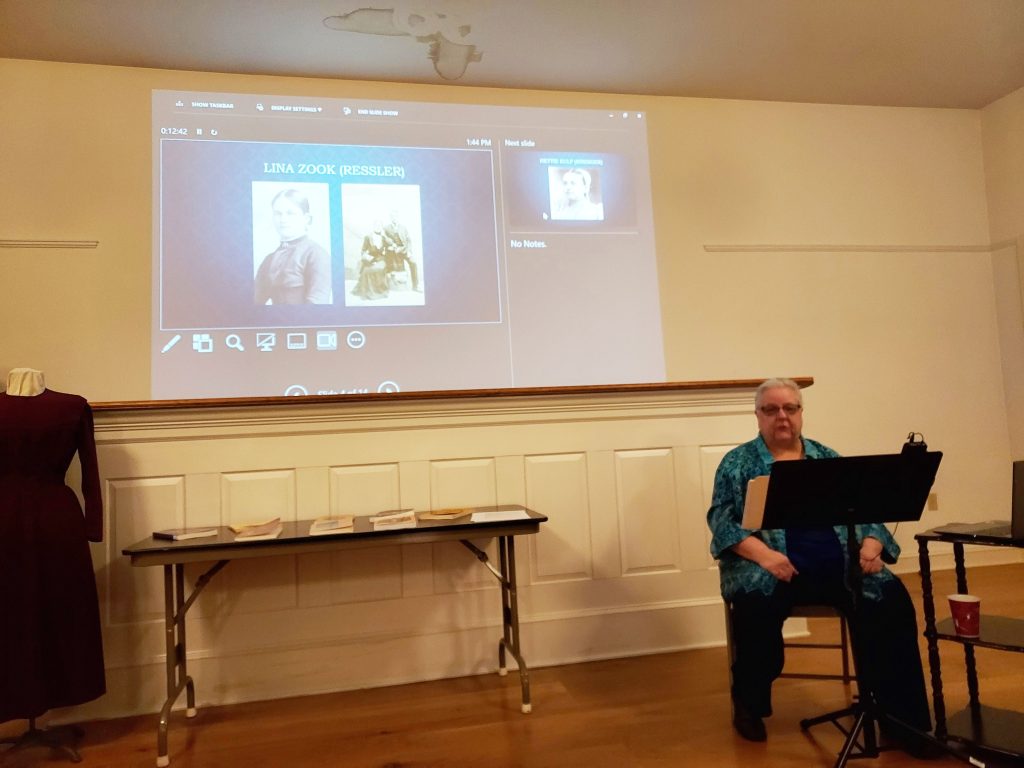
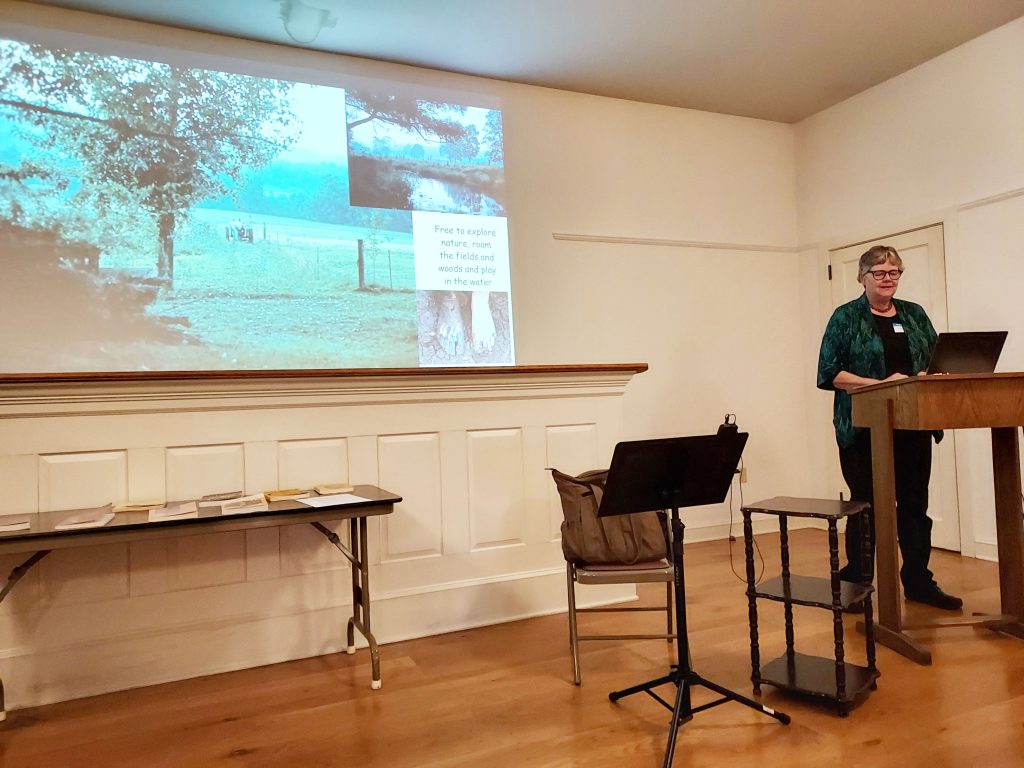
Carol Martin Johnson provided a modern-day counterpart to these historical women. She reflected on the messages she had received as a child about work and art and how that impacted her career. The admonishments heard and modeled for her were that creating beauty was alright if it served a useful purpose. After years of nursing as a profession in the U.S., and in Uganda with Mennonite Central Committee (MCC), she began to feel restless. She credits the Holy Spirit stirring in her that led her to become an art therapist. Helping others in a way that taps into her creativity has helped her to finally feel settled. The messages from her childhood have been transformed: now she knows that making art and beauty is not a luxury; it is essential to her wellbeing and way of existing in the world.
The program closed with comments and questions, a time of fellowship, and assembling MCC infant care kits from supplies brought by participants.
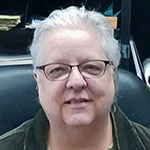
Anne M. Yoder
Anne M. Yoder served as the Archivist for the Swarthmore College Peace Collection, from which she recently retired. She is a member of West Philadelphia Mennonite Church and also attends Methacton Mennonite Church.




 one another. There was much singing together and the women enjoyed a delicious lunch including a wonderful cake gifted to them from MCUSA out-going Executive Director, Ervin Stutzman, from his retirement party the night before. It was bi-lingual day, with everything presented in English and Spanish, and was a deeply moving day, culminating in the women giving testimony as to where God had unfolded their darkness into light.
one another. There was much singing together and the women enjoyed a delicious lunch including a wonderful cake gifted to them from MCUSA out-going Executive Director, Ervin Stutzman, from his retirement party the night before. It was bi-lingual day, with everything presented in English and Spanish, and was a deeply moving day, culminating in the women giving testimony as to where God had unfolded their darkness into light.
 Once again the hard work of the planning committee and especially our miracle-working God made a way where there seemed to be no way, and we were able to enjoy a sacred day of fellowship, worship, and learning. We had the biggest group ever, with 80 registrants from 15 different churches. The largest contingent of over 20 women came from Centro de Alabanza de Fildelfia.
Once again the hard work of the planning committee and especially our miracle-working God made a way where there seemed to be no way, and we were able to enjoy a sacred day of fellowship, worship, and learning. We had the biggest group ever, with 80 registrants from 15 different churches. The largest contingent of over 20 women came from Centro de Alabanza de Fildelfia. We were asked to reflect on three questions throughout the day: Who do they (culture, family, etc.) say that I am? Who do I say that I am? Who does God say that I am? Pastor Tami told about her own journey of letting go of some of Grandmother’s purse as she stepped into God’s calling on her life to be a pastor.
We were asked to reflect on three questions throughout the day: Who do they (culture, family, etc.) say that I am? Who do I say that I am? Who does God say that I am? Pastor Tami told about her own journey of letting go of some of Grandmother’s purse as she stepped into God’s calling on her life to be a pastor. We were blessed by songs of worship led by women from Centro de Alabanza de Fildelfia, expert translation between Spanish and English by several women, wonderful snacks donated by a dozen registrants, a delicious luncheon prepared by Marta Castillo, and by the faith witness of those who attended.
We were blessed by songs of worship led by women from Centro de Alabanza de Fildelfia, expert translation between Spanish and English by several women, wonderful snacks donated by a dozen registrants, a delicious luncheon prepared by Marta Castillo, and by the faith witness of those who attended. As one participant wrote, when asked what they found most meaningful about the Gathering: “Connecting with sisters of a different culture and learning from their examples – I noticed how many shared, and how they usually began with ‘God is good’ even as they described hardship in their lives.” Similarly, another wrote in answer to the same question: “Joining of all cultures, all sisters, seeing tears, prayer, and sincerity.”
As one participant wrote, when asked what they found most meaningful about the Gathering: “Connecting with sisters of a different culture and learning from their examples – I noticed how many shared, and how they usually began with ‘God is good’ even as they described hardship in their lives.” Similarly, another wrote in answer to the same question: “Joining of all cultures, all sisters, seeing tears, prayer, and sincerity.” pportunity to reflect on the theme “Sistering for Life.” The term “sistering” refers to a practice in carpentry in which structural repairs are made by attaching new wood beams to weak (sagging, cracked or twisted) joists to make the original stronger. All of us are strong at times and can help those who are weak; all of us find it difficult to make it on our own at times and need others to support us. Sistering is a gift that we embody as God’s women who are following Jesus throughout our lives.
pportunity to reflect on the theme “Sistering for Life.” The term “sistering” refers to a practice in carpentry in which structural repairs are made by attaching new wood beams to weak (sagging, cracked or twisted) joists to make the original stronger. All of us are strong at times and can help those who are weak; all of us find it difficult to make it on our own at times and need others to support us. Sistering is a gift that we embody as God’s women who are following Jesus throughout our lives. A children’s story, “Four Feet, Two Sandals”, was read to illustrate how something as simple as sharing a pair of sandals at a refugee camp can build sisterhood. Leticia Cortes, pastor at Centro de Alabanza, led us in activities that required teamwork and seeing how we felt in each other’s shoes. A sandal was given to each participant to decorate and to write a message on; these were then exchanged with another woman, with whom a prayer and blessing were shared.
A children’s story, “Four Feet, Two Sandals”, was read to illustrate how something as simple as sharing a pair of sandals at a refugee camp can build sisterhood. Leticia Cortes, pastor at Centro de Alabanza, led us in activities that required teamwork and seeing how we felt in each other’s shoes. A sandal was given to each participant to decorate and to write a message on; these were then exchanged with another woman, with whom a prayer and blessing were shared. I felt great joy in spending time with the women who gathered on March 12th. Not knowing Spanish, I had the opportunity to experience what it’s like to be in the minority for once, but also to listen to a beautifully expressive language. Hearing the stories of women often moved me to tears and to laughter, and I marveled at the deep, and often exuberant faith that has emerged in spite of, or perhaps because of, difficult circumstances in their lives. Each year, this event challenges my faith journey and stretches my world-view. The Holy Spirit is alive and well and very evident as we meet. It is a privilege to take part in creating a holy space for this gathering to happen and to take part in it.
I felt great joy in spending time with the women who gathered on March 12th. Not knowing Spanish, I had the opportunity to experience what it’s like to be in the minority for once, but also to listen to a beautifully expressive language. Hearing the stories of women often moved me to tears and to laughter, and I marveled at the deep, and often exuberant faith that has emerged in spite of, or perhaps because of, difficult circumstances in their lives. Each year, this event challenges my faith journey and stretches my world-view. The Holy Spirit is alive and well and very evident as we meet. It is a privilege to take part in creating a holy space for this gathering to happen and to take part in it.




